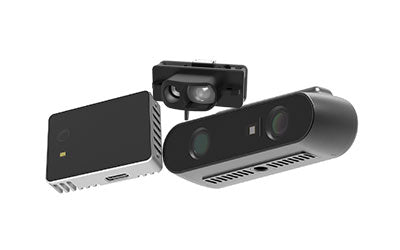ToF-Sensoren zur Kollisionsvermeidung von Drohnen: Intelligente Flugsicherheit

Mit der rasanten Weiterentwicklung der Drohnentechnologie haben sich ihre Einsatzmöglichkeiten in verschiedenen Branchen erweitert, darunter Logistik, Landwirtschaft, Überwachung sowie Such- und Rettungsdienste. Beim Fliegen in komplexen Umgebungen werden Hinderniserkennung und Kollisionsvermeidung jedoch zu entscheidenden Herausforderungen für einen sicheren Drohnenbetrieb. Herkömmliche Systeme basieren auf optischen oder Ultraschallsensoren, deren Präzision und Reaktionszeit jedoch begrenzt sind.
ToF -Sensoren (Time-of-Flight) , bekannt für ihre hochpräzise Distanzmessung , werden zu einem wesentlichen Bestandteil von Drohnen-Kollisionsvermeidungssystemen. Durch die Echtzeitmessung der Flugdistanz zwischen Drohne und Hindernissen bieten ToF-Sensoren intelligentere und schnellere Lösungen zur Kollisionsvermeidung und gewährleisten so sichere Flüge.
So funktionieren ToF-Sensoren
Was ist ToF?
ToF-Sensoren senden Lichtimpulse aus und berechnen die Flugzeit des Lichts bis zur Reflexion von einem Objekt. Dadurch werden hochpräzise Entfernungsdaten bereitgestellt. Dieser Prozess erzeugt 3D-Tiefeninformationen , die Drohnen helfen, Objekte zu erkennen und deren Entfernung und Position zu berechnen. Die Echtzeit-Sensorfunktion der ToF-Technologie gewährleistet hohe Präzision und schnelle Reaktion und eignet sich daher ideal für Drohnen, die in komplexen Umgebungen mit vielen Hindernissen fliegen.
Vorteile von ToF-Sensoren in Drohnen-Kollisionsvermeidungssystemen
-
Hochpräzise Hindernisvermeidung in Echtzeit
Im Vergleich zu herkömmlichen visuellen Sensoren und Ultraschallsensoren ermöglichen ToF-Sensoren wie Laser-Distanzsensoren und ToF-Kamerasensoren eine schnelle und präzise Entfernungsmessung. ToF-Sensoren gewährleisten selbst bei schwankenden Lichtverhältnissen oder komplexen Oberflächen eine hohe Genauigkeit und aktualisieren kontinuierlich 3D-Tiefenkarten, damit Drohnen Hindernissen sicher ausweichen können. -
Flugsicherheit bei jedem Wetter
ToF-Sensoren sind unabhängig von den Lichtverhältnissen und ermöglichen den sicheren Betrieb von Drohnen sowohl bei Tageslicht als auch bei schlechten Lichtverhältnissen. Daher eignen sich ToF-Sensoren ideal für Drohnen, die bei wechselndem Wetter oder schlechten Sichtverhältnissen eingesetzt werden, und gewährleisten eine präzise Hinderniserkennung unter allen Bedingungen. -
Schnelle Reaktion und intelligente Pfadplanung
ToF-Sensoren berechnen Entfernungen schnell und ermöglichen es Drohnen, ihre Umgebung während Hochgeschwindigkeitsflügen zu erfassen. Nähert sich die Drohne einem Hindernis, erkennt der ToF-Sensor dies sofort. Die Drohne kann ihre Flugroute automatisch anpassen und so einen sicheren Flug gewährleisten. In Gebieten wie Städten, Wäldern oder engen Innenräumen können Drohnen mithilfe der ToF-Technologie Hindernisse erkennen und vermeiden. -
Verbesserte Hindernisvermeidung durch Multi-Sensor-Fusion
ToF-Sensoren ermöglichen eine hervorragende Entfernungsmessung. Die Kombination mit anderen Sensoren wie LiDAR , Infrarotsensoren und Tiefenkameras verbessert die Hinderniserkennung und -vermeidung. Durch die Multisensorfusion können Drohnen umfassende Umgebungsdaten nutzen, was die Entscheidungsfindung und Genauigkeit bei komplexen Flügen verbessert. -
Anpassungsfähigkeit an dynamische Umgebungen
In dynamischen Umgebungen wie Lagerhallen, Baustellen oder Industrieanlagen ermöglichen ToF-Sensoren Drohnen, bewegliche Hindernisse wie Fahrzeuge oder Personen zu erkennen und zu vermeiden. ToF-Sensoren helfen Drohnen, Flughöhe und -richtung anzupassen und so eine sichere Navigation durch schwierige Bereiche zu gewährleisten.
Anwendungen von ToF-Sensoren in Drohnen-Kollisionsvermeidungssystemen
-
Logistik und Lieferung
Drohnen in der Logistik müssen in städtischen Gebieten mit zahlreichen Hindernissen wie Gebäuden, Stromleitungen und Bäumen navigieren. ToF-Sensoren ermöglichen es Drohnen, Hindernisse während des Fluges zu erkennen und zu vermeiden. So können Drohnen Pakete sicher in belebten Straßen oder engen Lücken zwischen Gebäuden zustellen. Bei Drohneneinsätzen in Innenräumen gewährleisten ToF-Sensoren die Hindernisvermeidung in beengten Umgebungen wie Lagerhallen. -
Drohneninspektion
Bei Aufgaben wie der Inspektion von Stromleitungen oder Brücken können Drohnen mit ToF-Sensoren nah an Hochspannungsleitungen oder -strukturen fliegen und Kollisionen vermeiden. Die Echtzeit-Daten des Abstandssensors gewährleisten, dass sich Drohnen Objekten sicher nähern und gleichzeitig genaue Daten für die Inspektion erfassen können. -
Land- und Forstwirtschaft
In der Land- und Forstwirtschaft werden Drohnen zur Ernteüberwachung, zum Einsatz von Pestiziden und zur Waldbewirtschaftung eingesetzt. ToF-Sensoren helfen Drohnen, den Abstand zu Nutzpflanzen und Bäumen zu messen, die Flughöhe automatisch anzupassen und Hindernissen wie Bäumen oder unebenem Gelände auszuweichen. Dies gewährleistet einen sicheren Betrieb in komplexen Umgebungen. -
Suche, Rettung und Notfallmaßnahmen
ToF-Sensoren unterstützen Drohnen bei der Navigation durch Katastrophengebiete wie Trümmer, Wälder oder bergiges Gelände und vermeiden Hindernisse bei Such- und Rettungseinsätzen. Die ToF-Technologie gewährleistet sicheres Fliegen durch anspruchsvolle Umgebungen und liefert Rettungskräften wichtige Echtzeitinformationen.
Zukünftige Entwicklungen für ToF-Sensoren in Drohnen-Kollisionsvermeidungssystemen
-
KI-gestützte intelligente Hindernisvermeidung
Die Kombination von ToF-Sensoren mit KI wird die Hindernisvermeidungssysteme von Drohnen weiter verbessern. KI-Algorithmen analysieren 3D-Daten in Echtzeit, sodass Drohnen Hindernisbewegungen vorhersagen und automatisch optimale Flugrouten wählen können. Dies verbessert die Flugsicherheit und -effizienz. -
Kollaborative Hindernisvermeidung mit mehreren Drohnen
Bei Operationen mit mehreren Drohnen helfen ToF-Sensoren den Drohnen, Kollisionen miteinander zu vermeiden und ermöglichen so koordinierte Flüge bei gemeinsamen Missionen. ToF-Sensoren erfassen die Entfernung und Position benachbarter Drohnen und ermöglichen so sichere und effiziente Gruppenflüge. -
Miniaturisierung und Integration
Zukünftige ToF-Sensoren werden kleiner und stärker in andere Drohnensysteme integriert, was das Gewicht reduziert und die Leistung der Drohne verbessert. Diese Miniaturisierung wird Drohnen in die Lage versetzen, komplexe Aufgaben in noch anspruchsvolleren Umgebungen zu bewältigen.
Abschluss
ToF-Sensoren spielen eine entscheidende Rolle bei der Verbesserung von Drohnen-Kollisionsvermeidungssystemen, da sie hochpräzise Entfernungsmessungen und 3D-Tiefenmessung in Echtzeit ermöglichen. Sie ermöglichen Drohnen die sichere und effiziente Navigation in komplexen Umgebungen in verschiedenen Branchen, darunter Logistik, Inspektion, Landwirtschaft und Notfalleinsatz. Die Weiterentwicklung der ToF-Technologie mit KI und Multisensorfusion wird auch weiterhin Innovationen in der intelligenten Hindernisvermeidung und im automatisierten Drohnenflug vorantreiben.
Synexens 3D RGBD ToF Tiefensensor_CS30
Unser professionelles technisches Team, spezialisiert auf 3D-Kamera-Entfernungsmessung, steht Ihnen jederzeit zur Verfügung. Egal, ob Sie nach dem Kauf Probleme mit Ihrer TOF-Kamera haben oder Fragen zur TOF-Technologie haben, kontaktieren Sie uns jederzeit. Wir legen Wert auf hochwertigen technischen Kundendienst und ein optimales Benutzererlebnis, damit Sie unsere Produkte unbesorgt kaufen und nutzen können.
-
Veröffentlicht in
CS30






